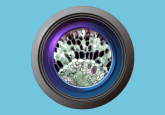X Line vision

A new range of Olympus microscope lenses break through barriers of image quality, performing at the forefront of lens technology across the board in numerical aperture, image flatness and chromatic correction.
Microscope lens quality has long been a juggling act between three key components of image quality: numerical aperture (NA), image flatness and chromatic correction. Selecting the appropriate lens for a task often results in a compromise in at least one of these areas. Addressing this hurdle in the field of microscopy, Olympus (Tokyo, Japan) has developed a series of lenses, labeled “X Line objectives,” that lead the way in providing top spec quality in all three areas.
The capability of a lens to capture light, and therefore capture images at a high resolution, is measured by its NA. Chromatic correction range describes the lens’ ability to limit the wavelength-dependent shift of colors in the X, Y and Z axis and determines the color accuracy. The better the chromatic correction range, the higher the precision of multicolor colocalization and measurement. Finally, image flatness indicates the lens’ capability to focus on the entire image.
“With this new range of objectives, Olympus not only improves raw image quality, but also helps to acquire more meaningful data, delivering enormous benefits to every microscope user.”
The company used a novel polishing technique to develop ultra-thin lenses with a NA of 1.45, a chromatic correction range of 400–1000nm and top of the range image flatness; figures that would normally only be seen in specialist lenses for each feature that would typically achieve such prestige by sacrificing at least one of the other areas.
The lenses are also easily incorporated into a variety of imaging systems, without the need to alter the parfocalizing distance or the mount. This allows for the simple upgrade of a microscope, increasing the instrument’s ability to yield high-resolution and high-quality image data across the board, improving diagnosis, image stitching, quantitative image analysis and many other microscope functions.
-
Matching objective lenses to experimental needs and budgets
-
How TruSpectral Technology works
-
Combination of two microscope technologies offers unprecedented look at biological processes in living cells
Extolling the benefits of the new lenses, Jan Barghaan, marketing manager at Olympus, stated that: “if your raw image isn’t great, you can post-process as much as you want, but you’ll never reach the quality of high-performance objectives. With this new range of objectives, Olympus not only improves raw image quality, but also helps to acquire more meaningful data, delivering enormous benefits to every microscope user.”
Alongside these X-Line objectives, Olympus also developed lenses specific for total internal reflection fluorescence microscopy, which requires a high NA. These UPLAPO-HR objectives are the only plan-corrected apochromat lenses available that yield a NA of 1.5, which is accompanied by a very high image flatness.





